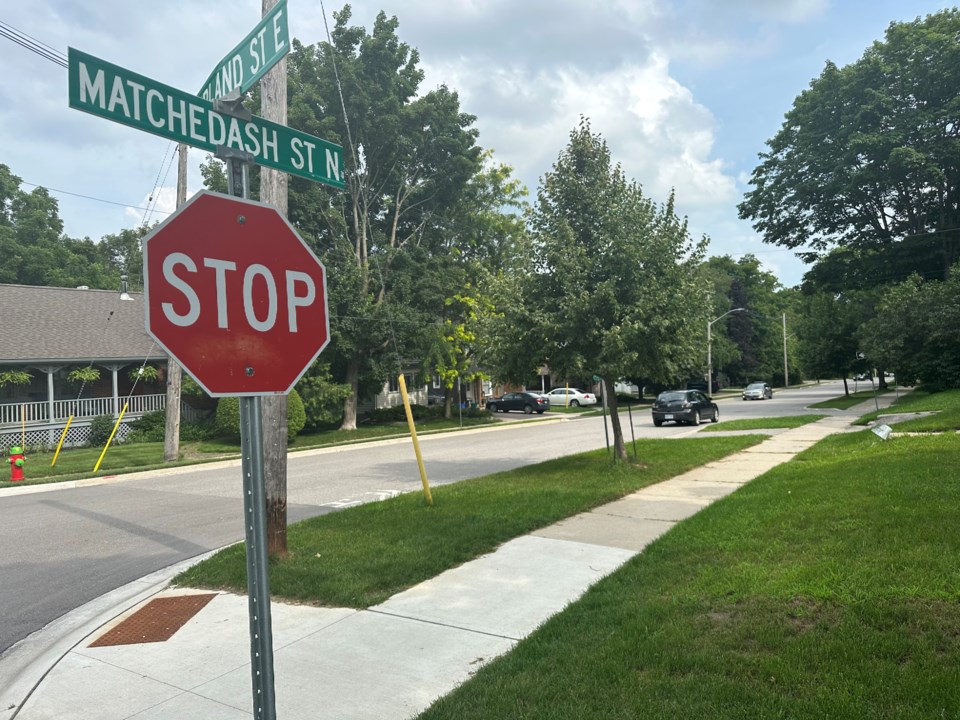Traffic on Matchedash Street North has increased five-fold since the Laclie Street reconstruction project began in June, city officials say.
Phase 1 of the project, scheduled for completion in November, has brought street closures to the area while work is carried out along Laclie Street from Neywash to Borland streets, as well as Tecumseth Street from Laclie Street to Centennial Drive.
Residents have complained about increased traffic volume on Matchedash Street, with one resident recently speaking to OrilliaMatters about speeding and traffic concerns, as well as collisions and near-misses along the residential street, which is also home to a bike lane and Hillcrest Park.
In response, city staff have been working to gather traffic data in the area in recent weeks, placing both a radar speed sign and a “nearly undetectable” Armadillo unit along Matchedash Street North.
“The data collected validates the complaints of the constituents with respect to traffic volume, and it has been determined that the total traffic count on the subject street has increased by approximately 500 per cent since the Laclie Street reconstruction detour started,” said Ian Sugden, the city’s general manager of development services and engineering.
Though the data confirm increased traffic volumes, Sugden said resident concerns about speeding have not been substantiated, with the average speed clocking in at 46 km/h and the 85th percentile speed being 52 km/h.
The city is now considering options to redirect traffic away from Matchedash Street North, Sugden said.
Previously, the city reprogrammed the traffic signals at Laclie and North streets to mitigate traffic build-up taking place at the intersection.
“One measure is likely to be a change in the detour route from North Street East to Fittons Road East so that traffic will detour further around the work zone, and would also have full signal-controlled intersections to use,” Sugden said.
“However, in order to effect this change in detour, further signal-timing changes are required at the intersection of Fittons Road East/West Street North.”
This measure will likely “take some time,” but will also benefit Phase 2 of the Laclie Street reconstruction project, Sugden said.
The goal of the measures is to ensure high traffic volumes do not affect other areas of the neighbourhood, as well, he said.
“Any other measures that may still be considered must ensure that local changes do not simply transfer the problem to the next parallel street (Peter Street North).”
Matchedash Street resident Kelly Lawless is “not surprised” city data confirm the dramatic rise in traffic along the road. He said he had to help a neighbour to safely back out of her driveway recently.
“That’s five times more than the usual, right? It’s a lot for the street to handle,” he said. “It’s risky to just back out (of a driveway).”
He said the city’s plan to drive traffic onto more appropriate streets, such as Fittons Road and the arterial West Street — as opposed to a parallel street, like Peter Street — sounds like a “promising solution.”
Resident Cheryl Lynch said she understands the traffic issues are temporary, but she stressed the importance of the city acting quickly due to the children in the neighbourhood.
“This is a neighbourhood full of small children — children walking to school, children walking back from school, walking down to the lake,” she said. “It takes two minutes for a tragedy to happen, so we need quick solutions.”
She was supportive of the idea to redirect traffic off of Matchedash Street, but she hopes to see quicker measures — like additional stop signs, or a reduced speed limit — implemented to increase safety while the city works to redirect vehicles.
“What’s going to happen when somebody gets killed or seriously injured there? We will look at the town council. We will look at the city planning,” she said. “Even if they put up a temporary stop sign, it would lessen the odds until they redirect it.”
